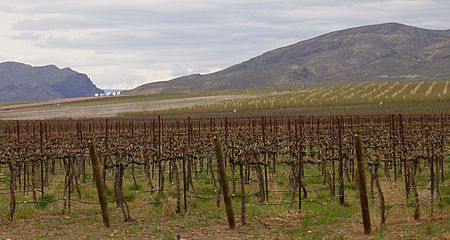Wahluke Slope facts for kids

The Wahluke Slope is a special area in Eastern Washington. It stretches across parts of Grant, Benton, and Adams Counties. It is a wide, gently sloping area that faces south. It sits between the Saddle Mountains and a part of the Columbia River called the Hanford Reach.
Scientists say it's like a huge gravel bar, about 13 miles wide. It was formed by massive floods from Lake Missoula about 15,000 years ago. These floods happened at the end of the last ice age. A big part of Wahluke Slope is within the Hanford Site. In 1999, much of this area became part of the Hanford Reach National Monument. This monument helps protect nature. The rest of the land is mostly used for growing grapes. This is called viniculture.
People and the Land
Washington State Route 24 is a road that runs across Wahluke Slope. It starts near Mattawa, Washington, which is the only town right on the Slope. Long ago, there was a town called Wahluke and a ferry that crossed the Columbia River.
In 1943, the U.S. government bought this land for the Hanford Site. People living there, including the Wanapum people, were asked to leave. Later, in 1953 and 1958, the Atomic Energy Commission returned about 200,000 acres (809 square kilometers) of land. Most of this land was used for farming. New irrigation water came from the Columbia Basin Project.
Settling on the Slope was sometimes difficult for non-Native Americans. First, there wasn't enough water. Then, government land rules made it hard. This led to slow growth for the town of Mattawa.
Safety and the Hanford Site
The Hanford Site was a place where nuclear materials were made. People have worried about the chance of harmful nuclear materials getting into the Wahluke Slope. There were also some releases of these materials into the air in the past. These concerns are important to people who study Hanford today.
Growing Grapes
Growing grapes for wine, known as viniculture, is a very important type of farming on the Slope. There are nearly 10,000 acres (40 square kilometers) of vineyards here.

